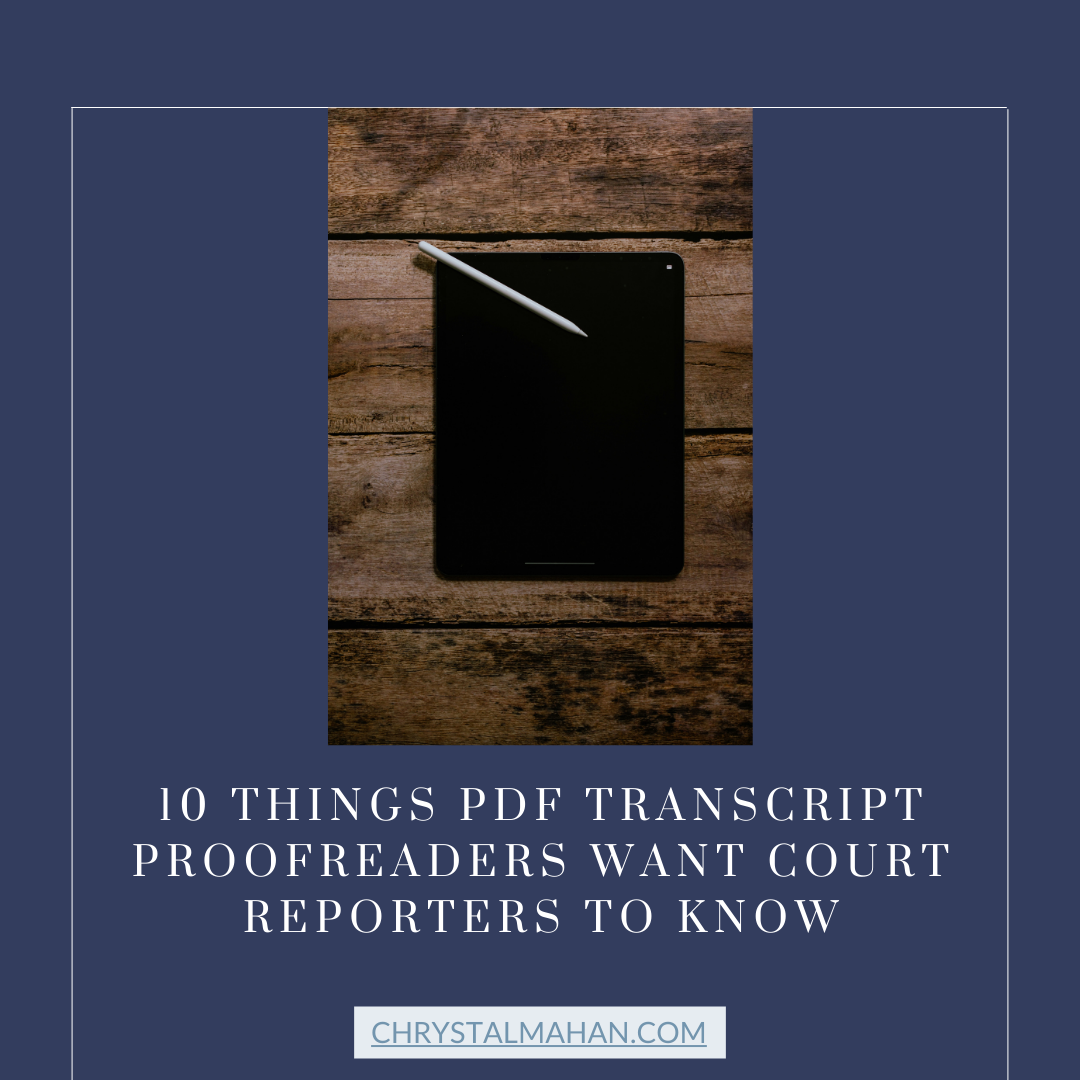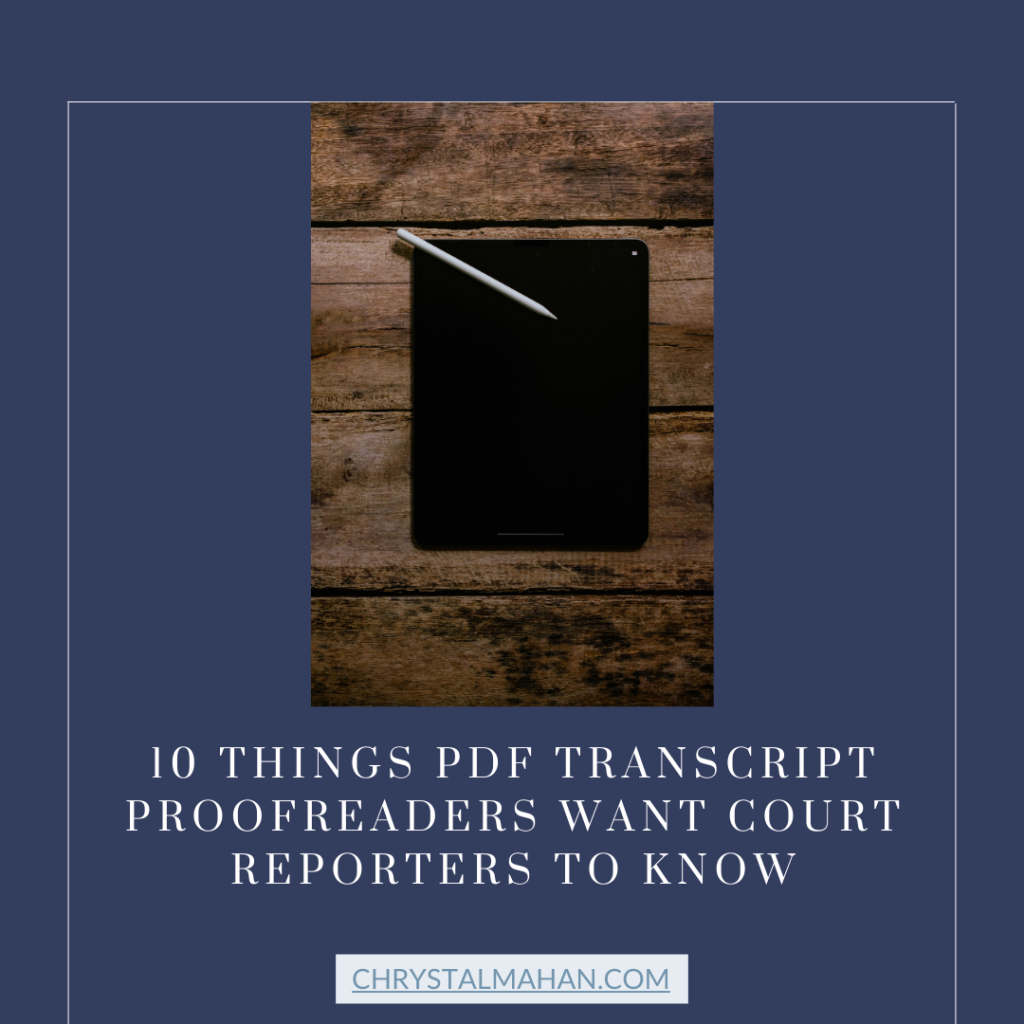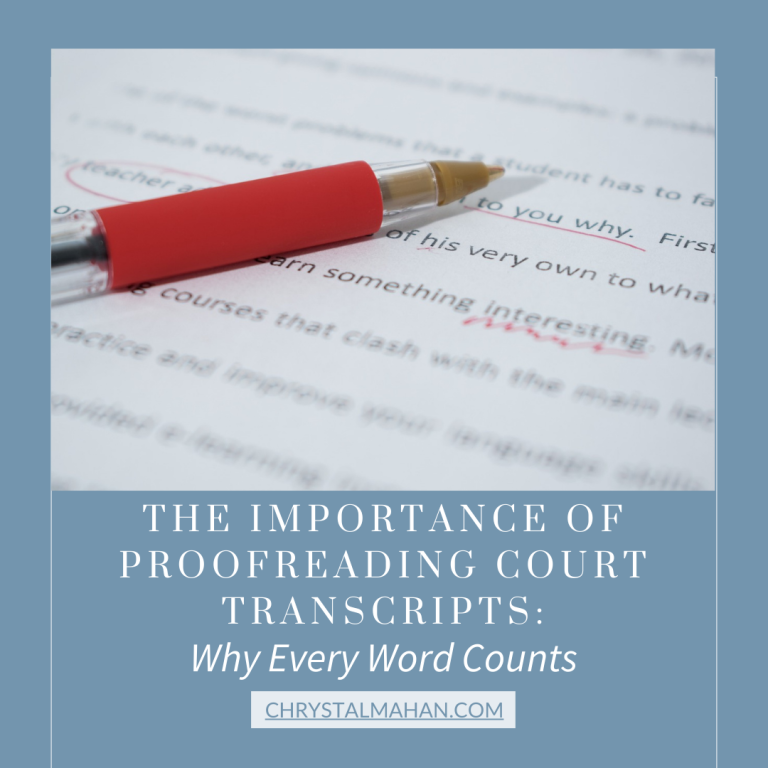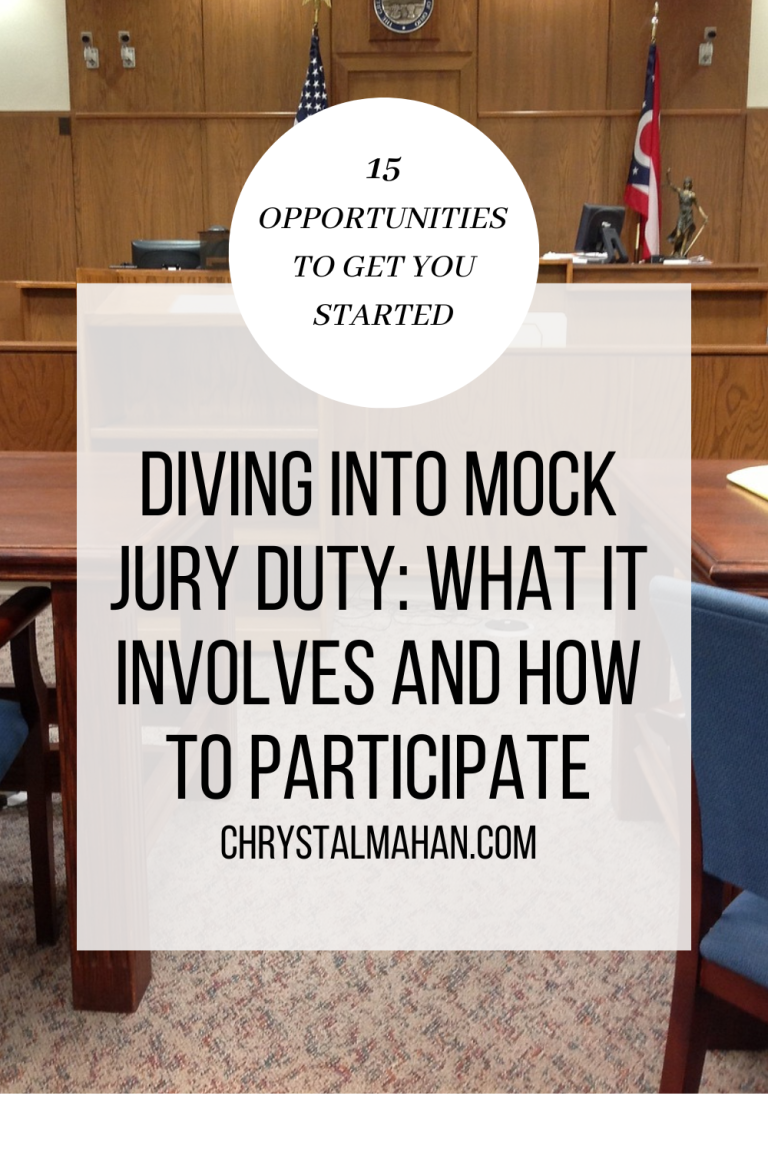10 Things PDF Transcript Proofreaders Want Court Reporters to Know


Photo by Kelly Sikkema on Unsplash
In the world of legal proceedings, precision is everything. Court reporters are critical in ensuring an accurate record of depositions, trials, and hearings. But beyond the initial capture of words lies a crucial step: transcript proofreading. For many court reporters, the work is far from over when the gavel strikes. This is where proofreaders come in, carefully combing through transcripts to catch errors, omissions, and inconsistencies. Yet, despite the importance of proofreading in delivering a flawless transcript, the communication between court reporters and proofreaders often leaves much to be desired.
Picture this: You’ve just spent hours, maybe even days, transcribing testimony. The hard work is done—or so you think. You send the PDF transcript off to your proofreader, only to receive it back covered in corrections, many of which could have been avoided with clearer communication or mutual understanding. This scenario is more common than many might think, causing frustration on both ends of the process.
Let’s change that. This blog post will explore the top 10 things PDF transcript proofreaders want court reporters to know. By fostering better communication and setting expectations from the start, court reporters and proofreaders can build a stronger, more efficient working relationship. Whether you’re a seasoned court reporter or just starting out, this insight could be a game changer for your workflow and, ultimately, your client satisfaction.
Why Proofreading Matters
Before diving into the specifics, it’s important to understand why proofreading matters so much to the court reporting process. Legal documents require absolute precision, and even the smallest error can have serious consequences. PDF transcript proofreaders serve as the final safeguard, ensuring that every word, comma, and formatting choice aligns with the standards of the legal field. When proofreaders and court reporters work seamlessly together, the end result is a flawless transcript that reflects professionalism and attention to detail.
1. Consistency is Key
One of the most challenging issues for proofreaders is the inconsistency found in transcripts. From formatting changes to fluctuating terminologies, consistency—or the lack thereof—can significantly impact the quality of the final transcript. Court reporters should aim for uniformity in every aspect of their work, whether it’s abbreviations, punctuation, or speaker identification.
Inconsistent formatting can make the proofreader’s job much more challenging, as they must correct errors and bring the document into alignment with standard practices. When court reporters maintain consistency, it saves both time and effort, ensuring that proofreaders can focus on actual errors instead of spending time correcting preventable inconsistencies.
To mitigate this, court reporters should consider developing and sharing a style sheet or glossary that outlines how they prefer certain terms and formats to be used throughout the document. This will help both parties work more efficiently and minimize back-and-forth corrections.
Proofreaders can also create a preference sheet to share with a court reporter when they start working with them. I have done this, and I can tell you it helps, especially when you have court reporters nationwide and in different court systems with different rules and preferences for how a transcript should be produced.
2. Punctuation Can Change Meaning
Many court reporters underestimate the power of punctuation. Proofreaders often find themselves correcting misplaced commas, colons, and semicolons that can change the meaning of a sentence entirely. A simple comma can alter the context of a deposition or court testimony, which may lead to misinterpretation in a legal case.
Court reporters should take extra care to use punctuation correctly, especially in legal contexts where precision is paramount. While a proofreader can catch most punctuation errors, the fewer they find, the smoother the process will be for both parties.
Proofreaders appreciate it when court reporters recognize that punctuation isn’t just a technicality; it’s a vital tool for maintaining clarity and accuracy in the legal record. Taking a few extra seconds during the transcription process to ensure punctuation is accurate will save time and prevent misunderstandings later.
3. Audio Quality Affects Accuracy
Proofreaders rely heavily on the accuracy of the original transcript, which is often influenced by the quality of the audio recording. Poor audio quality can lead to misheard or misunderstood words, which then trickle down to the transcript. This can result in a proofreader flagging issues that are actually due to unclear audio, not the court reporter’s transcription skills.
It’s important for court reporters to prioritize high-quality audio equipment and ensure they’re capturing clear sound during proceedings. Investing in quality recording tools can reduce the number of errors in the initial transcript, making the proofreader’s job easier and cutting down on revisions.
If there are sections of the recording that are particularly difficult to hear, court reporters should communicate this to the proofreader. Highlighting these areas can prevent unnecessary corrections and clarify the source of any confusion.
4. Proofreaders Are Not Editors
One common misconception court reporters have is that proofreaders will fix everything, including editing the content. In reality, proofreaders are there to correct spelling, punctuation, grammar, and formatting errors, not to rework the structure or make content changes.
Court reporters need to be aware of the difference between proofreading and editing. Proofreaders are not responsible for verifying the accuracy of the content, changing word choices, or restructuring sentences to make them sound better. Their primary role is to ensure the transcript adheres to legal standards and is free of typographical errors.
By understanding this distinction, court reporters can avoid placing unrealistic expectations on proofreaders and ensure they receive the appropriate level of review for their work. If the transcript needs deeper revisions, it’s essential to hire an editor in addition to a proofreader.
5. Timely Communication is Crucial
Just like court reporters work under tight deadlines, proofreaders often face similar time constraints. Delays in communication, whether in sending the transcript or responding to queries, can slow down the entire process and put everyone under unnecessary pressure.
Court reporters should strive to communicate clearly and promptly with their proofreaders. This includes giving enough time for the proofreader to complete their work and being available to answer any questions or clarifications. The more streamlined the communication, the quicker the transcript can be finalized and sent off to clients.
It’s also helpful to establish expectations from the outset, such as turnaround times, preferred communication methods, and how to handle urgent deadlines. This ensures that both parties are on the same page and that the work is completed without last-minute stress.
6. Formatting Matters as Much as Content
For proofreaders, proper formatting is just as important as the content of the transcript. Court reporters should ensure that their formatting choices—such as margins, line spacing, and font size—are consistent and meet the standards of the legal field.
When a transcript has uneven formatting, it makes the proofreading process significantly harder. Proofreaders have to correct the formatting while simultaneously checking for errors, which can slow down the entire process. By providing a clean, well-formatted document from the start, court reporters can make their proofreaders’ jobs easier and more efficient.
Consistency in formatting also adds a layer of professionalism to the final product, making sure that the transcript looks as good as it reads. Court reporters should double-check their work before sending it off to catch any potential formatting issues.
7. A Clean PDF Saves Time
When court reporters submit their transcripts for proofreading, it’s critical to ensure that the PDF file is clear, readable, and free from extraneous marks or artifacts. Proofreaders often receive PDFs with poorly scanned pages, faded text, or unnecessary notations, which can hinder their ability to work efficiently.
By submitting a clean, high-quality PDF, court reporters ensure that proofreaders can focus on the task at hand—correcting errors—instead of struggling to decipher unclear text or dealing with unnecessary distractions. Small details like this make a big difference in the speed and quality of the proofreading process.
8. Repetition Increases Efficiency
Court reporters who consistently work with the same proofreader often experience faster, smoother collaborations. By establishing a long-term working relationship, both parties become familiar with each other’s preferences, workflows, and expectations.
Consistency in working together allows proofreaders to understand the court reporter’s style, which reduces the need for excessive corrections and clarifications. Over time, this partnership becomes more efficient, benefiting both the court reporter and the proofreader.
9. Every Error Affects Your Reputation
Ultimately, the quality of a transcript reflects the professionalism of both the court reporter and the proofreader. Even a small error can tarnish a court reporter’s reputation, especially in high-stakes legal environments. Proofreaders understand this and work diligently to catch every mistake, but they also rely on the court reporter to deliver an accurate transcript from the start.
Court reporters should remember that their reputation is on the line with every transcript they submit. Working closely with a trusted proofreader ensures that the final product is flawless and meets the highest standards of accuracy.
10. Proofreaders Are Your Teammates
At the end of the day, proofreaders and court reporters are working toward the same goal: delivering a flawless, professional transcript. Proofreaders are not there to criticize but to collaborate. When court reporters view proofreaders as teammates rather than critics, the entire process becomes more productive and less stressful for everyone involved.
Building a strong, respectful working relationship with proofreaders will only benefit court reporters in the long run. Open communication, mutual respect, and a shared commitment to quality are the foundation of a successful partnership.
Building Stronger Partnerships, One Transcript at a Time
The relationship between court reporters and proofreaders doesn’t have to be fraught with misunderstandings. By understanding the proofreader’s role and addressing common issues upfront, court reporters can improve their workflow, produce better transcripts, and foster stronger professional relationships. Clear communication and consistency are key to ensuring that the final product is flawless and delivered on time.
Join Me for Coffee
Want to dive deeper into the world of legal virtual assistance and court reporting? Let’s keep the conversation going!
Like what you read? Drop me a line – let’s chat over virtual coffee.
~ Chrystal






